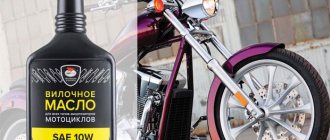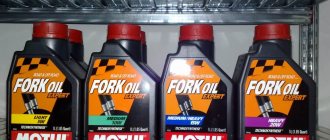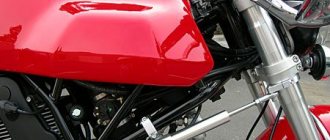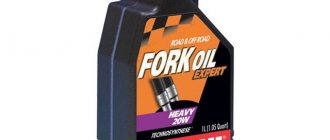Why is this procedure necessary?
The oil in the front shock absorber is changed for a variety of reasons. It has certain functions, and once you understand them, it will become clear why you should change it:
- Provides the necessary rigidity when the suspension is activated on uneven roads;
- Collects metal shavings generated during operation;
- Maintains steering and braking control.
Over time, it draws moisture from the atmosphere (despite the apparent tightness of the structure) and becomes less viscous. This leads to the fact that the vehicle begins to “nod” when braking, may jam, and instability will be especially felt during sharp turns at high speeds, with strong backing.
If the substance accumulates a lot of metal shavings, this provokes rapid wear of the parts, up to the deterioration of the surface of the feathers (and replacing them is a completely different price category for repairs, and it is better not to let this happen).
How often should I replace it?
The frequency of this manipulation for each vehicle model is specified in the user manual. On average, this interval is 12-15 thousand kilometers for road bikes, and 5-10 thousand for enduro.
But the majority of motorcyclists believe that “as long as it works, there’s no point in getting into it.” If the fork is stiff enough, absorbs well, and nothing leaks from it, then you can ride without any doubts. The oil is changed most often in the following cases:
- “Snotty” from under the seals;
- The equipment stood idle for a long time;
- I want to experiment with stiffness.
You can check if the fork is leaking quite simply. To do this, you need to sit on the bike, hold down the front brake, and strongly “rock” the bike back and forth. Then carefully examine the surface of the feathers. If there are clearly visible stripes on it, then it’s time to service the unit. If there is nothing visually, but when wiping the metal with a clean white napkin, traces remain on it, it means that the part is still “good”, but you need to keep in mind its prompt servicing.
Which oil should you choose?
The further operation of the front shock absorber will depend on its choice. Special fork oil has certain characteristics and is best suited, since it is designed both for the pressure created inside and for its heating during operation. The degree of viscosity, indicated by the number next to the letter W, can be used to adjust the stiffness of the fork.
- 5W – suitable for “sports” driving on a track with perfectly smooth asphalt;
- 10W – universal, used on most bikes;
- 15W is hard and viscous, it is poured into shock absorbers of either heavy cruisers with powerful springs, or when the feathers are quite worn out, when a fluid with a lower viscosity begins to leak. If you pour it into a lightweight small-capacity tank, it will seem like there is no suspension at all.
There are even craftsmen who pour motor oil into the front shock absorber. But we do not recommend doing this, since its characteristics are unpredictable, and no one has tested how it will behave when heated.
I used to live peacefully, like many others. I poured oil into the fork with a viscosity as per the manual, 10W, and didn’t bother too much about the manufacturer or any magical special properties.
But one day, one good (in the good sense of the word) person in a chat dedicated to discussing the coronavirus and alcoholism of motorcycles of a certain model, wrote that he chooses oil based on some kind of viscosity, and that not all are suitable. He even sent plates with characteristics, and subsequently, a link. With my usual zeal to thoroughly understand everything that is important to me (and motorcycles are oh how important to me!) I began to study various sources, which turned out to be Russian-speaking cyclist communities and foreign resources.
I invite anyone interested in choosing the best fluids for their motorcycle to review some of the findings I have made and discuss the results. In this article we will talk about the viscosity of fork oil, the dependence of this viscosity on temperature, and how you can choose the best one.
Disclaimer
This article was written for those who want to practice a more or less scientific approach in choosing.
I have nothing against the opinions existing somewhere else: “Who cares what you pour, you won’t understand anything”, “You’re not an athlete, why bother, you don’t need it for additional supplements” and “Why is it so difficult, try a dozen different and you yourself will understand,” the article was not written for these people. Ride anything. I want my suspension to perform correctly, the way the engineers (who are probably more qualified than these commentators) designed it, and to do so over the widest possible temperature range. If you think you don’t need it, that’s your right, I respect it. If you think that others, and in particular, me, do not need this, go to the forest, comrades. Why not use what is written in the manual? 1) Sometimes the manual only writes viscosity, which means little, without a specific manufacturer and brand. You can find a branded oil, for example, Showa, or one that is poured into WP, of this viscosity, and take it. 2) But, even if something specific is written there or you find oil from the fork manufacturer, it is not at all a fact that you will be able to buy it, especially if you live in a country where they read and speak Russian. 3) Even if it is, there is a high chance of finding something that will have the same characteristics, but in a wider temperature range, or similar ones in the same range, but will be more accessible or cheaper.
The information present in the article is how I understood everything that I managed to study. In no way do I pretend to have absolute knowledge on the matter. If you have something substantive to say, I will be glad.
I in no way vouch for the reliability of all the data in the table, because they were obtained for the most part from third hands, mainly by recognizing pictures from the first link below. The Excel file is working, you can edit all the indicators yourself offline, or write to me, attaching a link to the reliable correct characteristics of the oil, so that I can add/correct.
About fork oil
Viscosity
Any oil has a certain viscosity.
Typically, viscosity is measured in centistokes (cSt in our language or cSt in the bourgeoisie). These centistokes are not a constant value for oil. They change depending on a lot of things. In particular, there are two main factors - the temperature of the oil, and its aging, caused either by oxidation or by products formed during friction. I haven’t figured out aging, but I don’t need to yet, because it’s not yet clear how to apply it. The SAE classification, the one indicated on the bottle as 10W or 10Wt , determines what viscosity the oil will have... at 100 degrees Celsius! Moreover, what is important for us is that it determines only the lower limit of viscosity at 100C, and the same 10W can include oils with a viscosity of both 4.1 cSt and 5.6 cSt, and this will give a viscosity increase of more than 25%. And these are the same 10W! At the same time, of course, the SAE standard provides for indicators of low-temperature (from -10 and below) pumpability and crankability, which I have not yet seen the point of understanding, since I don’t drive at negative temperatures (almost), and they affect the flatness of the viscosity curve it is not known how, because, in theory, some additives are already starting to work there, and this is not the “ideal oil” in the middle operating range. The difference in oil classes, with seemingly identical dynamic viscosity characteristics, is due precisely to low-temperature requirements.
Fortunately, many manufacturers indicate either viscosity at 40 and 100 separately, or one of them, and some coefficient by which the second can be determined. Most often, this is the VTC coefficient:
VTC = 1-v100/v40 v100 = v40*(1-VTC) v40 = v100/(1-VTC)
Dependence of viscosity on temperature.
And here we come to the most interesting part. The viscosity of oils depends on temperature, it depends strongly, and the degree of this dependence varies for different oils. Take, for example, several oils labeled SAE 10W: Just take a look! At 40C Honda and Motul fork oil expert have the same viscosity, but at +5 Motul will be twice as thick, and at +100 it will be twice as thin as Honda, which will of course affect the performance of the suspension. Or take, for example, two oils from Motul, which are labeled the same at 100 and have the same viscosity, but at +5 they differ enormously! This very dependence of oil viscosity on temperature is to blame. It is usually characterized by the VI , which is calculated using a terrible formula, but, fortunately, is often simply indicated. The higher this index, the more stable the oil.
What to choose?
Regarding the choice of fork oil, I have formed the following beliefs: 1) The oil should have the highest possible VI, i.e. be as stable as possible in temperature , since the oil in the fork does not have a specific operating temperature, and its temperature very much depends on riding conditions and ambient temperature. 2) The oil must correspond to the viscosity characteristics specified by the manufacturer at operating temperature , unless, of course, you have made changes to the suspension design, for example, you have not changed the stiffness of the spring or washer, and you operate the motorcycle under average conditions.
The same Excel program will help you choose, with the ability to search, filter and view graphs. It's at the very bottom of the article.
So how do you know what kind of oil to pour???
I don't know (and thanks for reading this far, haha!). The problem I have so far is that I don’t yet have any information about the temperature range of the oil in the fork. So, as soon as the weather gets a little better, I’ll attach a thermocouple to the plug and start making circles around the area. So, if the article finds its reader here, it will be continued. At the very least, it is clear which oil will perform better under different conditions, and which will greatly depend on them.
What if there is no such thing?
It’s okay, oil from the same line from the same manufacturer can be mixed. At the same time, the final viscosity can be calculated accurately using the calculator at the link below. I also saw from one of the oil manufacturers an option for calculating viscosity according to SAE using a simple proportion (like, if you need 10W, and you have 5W and 15W, just mix them in half), but I fixed the link, and no matter what.
Sources
It all started with this article, most of the data, incl. The plate data is from there. More general information on the topic. About how to complete the dependence of viscosity on temperature, having two points. About the classification of oils according to SAE. Mixture viscosity calculator
File with results
Algorithm of actions
To change the oil in the front shock absorber, it is not at all necessary to take your bike to a professional service center. Most riders cope well with this task themselves if they adhere to a simple list of actions:
- Stock up on keys, rags, containers, fork oil purchased in advance;
- Hang the front wheel, making sure that the device is stable;
- Unscrew the top plugs in each feather;
- Place a tray, cut canister or other container to collect the oil;
- Unscrew the lower plugs in each feather - waste will immediately flow out of them;
- Drain the old slurry completely by moving the feathers up and down along with the wheel (in some cases it can be removed so as not to get dirty and it is physically easier to move the feathers);
- Screw from the bottom;
- Pour in new oil in the amount specified in the manual;
- Screw on top.
This is an algorithm of actions for a simple replacement. But it is worth considering that on some motorcycles there are no traffic jams below. In this case, you need to remove the feathers from the traverses and drain the waste by turning it over. If your seals are leaking, they will have to be replaced. To do this, the fork must not only be removed, but also disassembled, thoroughly washing the internal structures and springs, and then reassembled using new seals and anthers.
Servicing upside-down forks is no different from classic ones. True, there are often no drain plugs, so the feathers will have to be removed in almost all cases.
Preparatory work
Although the process of changing the oil is a difficult job, if you approach the matter wisely, you can cope with even such a task. First of all, it is important to prepare everything you need, we will need the following tools:
- Funnel.
- Mallet.
- Kerosene.
- Socket and open-end wrenches.
You still need to prepare an unnecessary container in advance, it could be a 5-liter bottle or an old canister. We will need it to drain the used lubricating fluid. If you don't think about this important detail, you'll simply fill your entire garage with oil.










